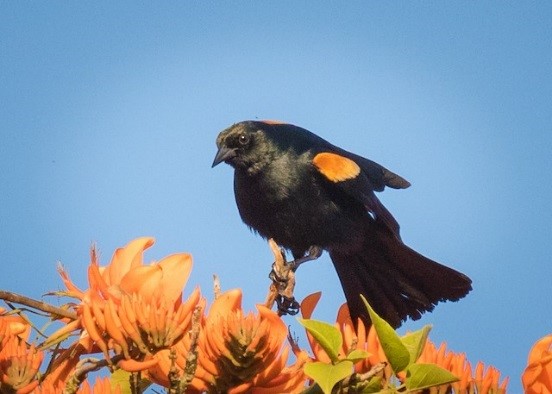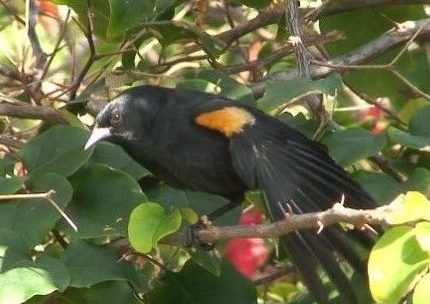Birdfinding.info ⇒ Common in many parts of Cuba, including Ciénaga de Zapata National Park and its surroundings. Often seen on drives while passing through agricultural areas and towns. Not difficult to find in and around Havana and several other Cuban cities. Very rarely reported from its limited Haitian range.
Tawny-shouldered Blackbird
Agelaius humeralis
Endemic to Cuba, its adjacent keys, and Haiti.
Generally common across much of Cuba in light woodlands and other semiopen habits, including agricultural and urban areas. Uncommon on several of the keys off of Cuba’s northern and southern coasts, where it inhabits scrub and mangroves, but rarely reported from the Isle of Youth.
Rare and local in Haiti, where it has been reported from two areas: the central coastal lowlands near the mouth of the Artibonite River and along the northern coast near Port-de-Paix.
Unlike most members of its genus, Tawny-shouldered is not associated with marshes. Like the others, it is highly gregarious and forms large flocks when not breeding.
Identification
Adult males are black overall with a rusty epaulet that is mostly concealed when the wing is folded tightly. The lower edge of the epaulet blends to a pale shade of tan.
The precise coloration of the epaulet can vary from tawny to chestnut to brick-red. In the latter case, the tan bar contrasts more sharply, inviting confusion with Red-shouldered and Red-winged Blackbirds. (See below for detailed comparisons.)
Females are very similar to males, but a less glossy shade of black, with a slightly reduced epaulet.
Immatures are similar to adults, but with small, less distinct epaulets.


Tawny-shouldered Blackbird, male displaying. (Palpite, Matanzas, Cuba; April 5, 2016.) © John Drummond
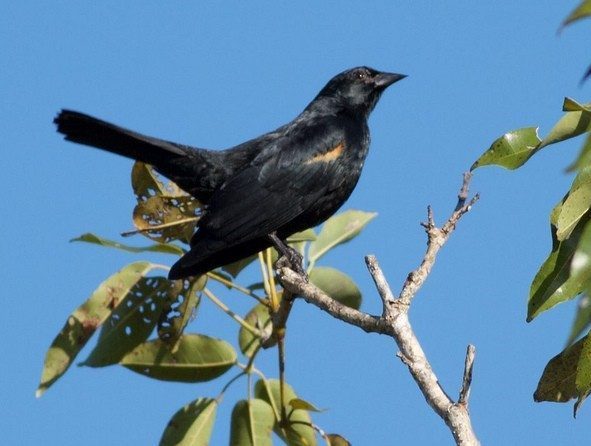
Tawny-shouldered Blackbird. (Soplillar, Matanzas, Cuba; February 24, 2015.) © Sarah Lane
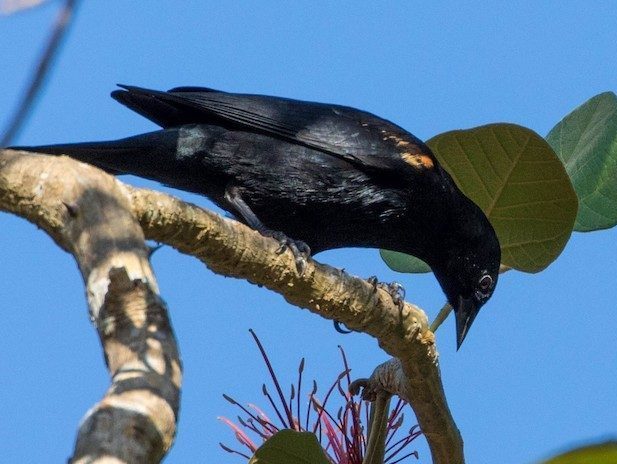
Tawny-shouldered Blackbird. (Cueva de los Portales, Pinar del Río, Cuba; March 18, 2018.) © Mel Senac
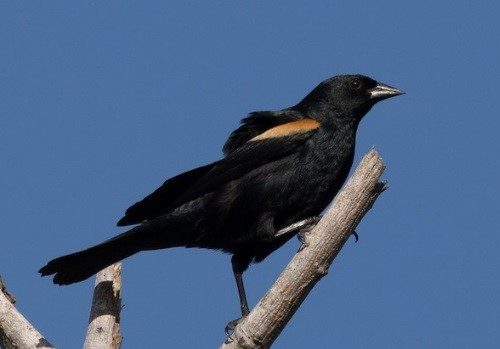
Tawny-shouldered Blackbird. (Playa Pesquero, Holguín, Cuba; February 18, 2018.) © Suzanne Labbé
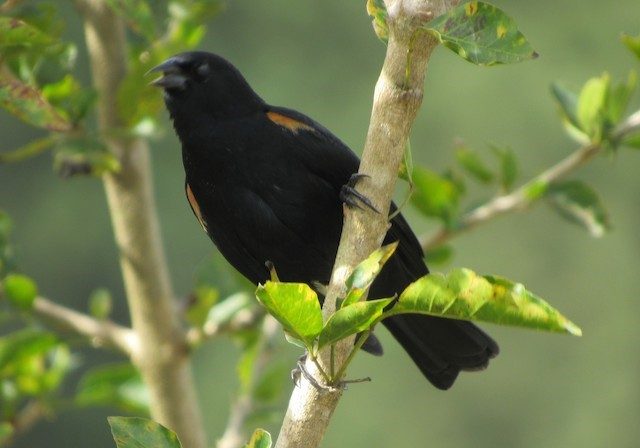
Tawny-shouldered Blackbird. (Topes de Collantes National Park, Cuba; February 22, 2016.) © Lawrence Gardella
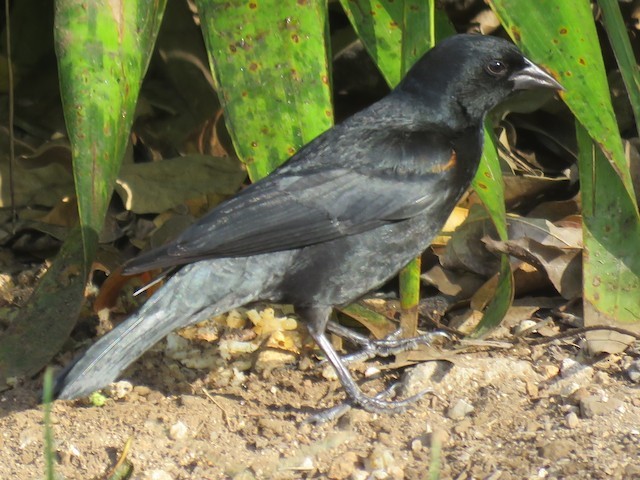
Tawny-shouldered Blackbird, with epaulet mostly concealed. (Cueva de los Peces, Matanzas, Cuba; January 1, 2017.) © Kent Fiala
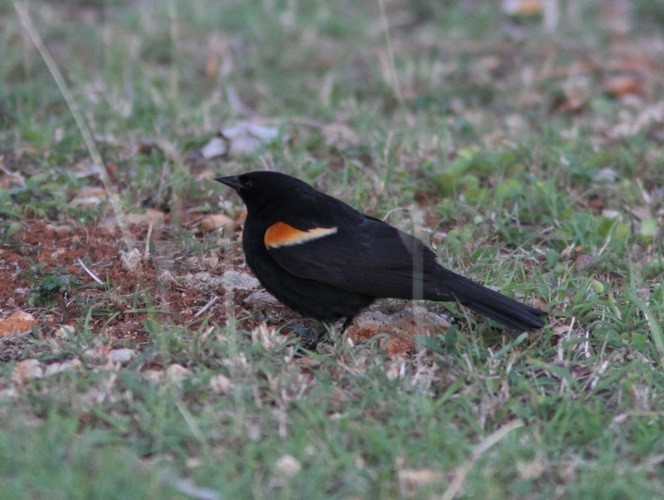
Tawny-shouldered Blackbird. (Cuba; May 6, 2013.) © William Price
Voice. Song is described as a muffled, buzzy zwaaaaaaaa that lasts about a second. Otherwise gives various contacts calls, many of which are metallic and high-pitched:
Tawny-shouldered Blackbird: Epaulet Comparison
These two photographs show the same individual, a long-staying vagrant Tawny-shouldered Blackbird on Grand Cayman Island. In the 2016 photo, its epaulet appears tawny with a smooth transition to tan (⇒ unambiguously Tawny-shouldered), but the 2018 photo appears to show contrasting red and pale panels (⇒ readily misidentified as Red-winged or Red-shouldered).

Tawny-shouldered Blackbird. (George Town, Grand Cayman Island; May 29, 2016.) © Denny Swaby
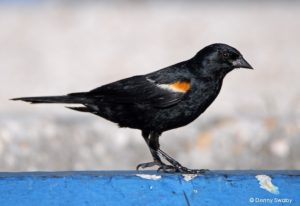
Tawny-shouldered Blackbird. (George Town, Grand Cayman Island; July 1, 2018.) © Denny Swaby
Cf. Red-shouldered and Red-winged Blackbirds. In western Cuba, the marsh-dwelling Red-shouldered Blackbird can be confused with Tawny-shouldered. Considering the short flight required to cross the Florida Strait, it is also likely that Tawny-shouldered and Red-winged Blackbirds sometimes occur in one another’s ranges, undetected—the only definitively documented case was of two male Tawny-shouldered Blackbirds collected at Key West in 1936.
Although the colors of the epaulets are usually sufficient to identify these species, the epaulets are often concealed and all have a pale lower edge that is often the only visible part. In addition, the immature male Red-shouldered can have a brownish epaulet, thus resembling Tawny-shouldered. Even among adults of these species, there is enough color variation to create confusion: Red-shouldered’s epaulet can sometimes appear burnt-orange, and Tawny shouldered’s can appear reddish (see inset below).
Other factors that can be useful to identify ambiguous Cuban blackbirds include:
Habitat: A strong initial indicator, as Red-shouldered rarely wanders far from marshes, whereas Tawny-shouldered is largely arboreal and favors woodland edges. However, these preferences are not absolute, and both species are at times found in fields and trees.
Voice: Most of Tawny-shouldered’s calls are metallic and high-pitched, whereas Red-shouldered’s common contact call is a much deeper chuck!
Female Plumage: These are social birds that are usually encountered in flocks, so it is often possible to identify them based on multiple individuals. In Tawny-shouldered, the sexes are similar, whereas the female Red-shouldered is all-black.
Bill Shape: On average, Tawny-shouldered has a shorter bill than Red-shouldered and Red-winged. This can be hard to judge in isolation, but is useful when an otherwise dubious individual shows a long, thin bill, confirming that it is not Tawny-shouldered.
Notes
Polytypic species consisting of two recognized subspecies: humeralis and scopulus. The latter is known only from Cayo Cantiles, in the archipelago east of the Isle of Youth. It is smaller and proportionately shorter-winged than the nominate subspecies, but has a longer, thinner bill.
References
eBird. 2018. eBird: An online database of bird distribution and abundance. Cornell Lab of Ornithology, Ithaca, N.Y. http://www.ebird.org. (Accessed October 22, 2018.)
Garrido, O.H, and A. Kirkconnell. 2000. Field Guide to the Birds of Cuba. Cornell University Press, Ithaca, N.Y.
Jaramillo, A., and P. Burke. 1999. New World Blackbirds: The Icterids. Princeton University Press, Princeton, N.J.
Latta, S., C. Rimmer, A. Keith, J. Wiley, H. Raffaele, K. McFarland, and E. Fernandez. 2006. Birds of the Dominican Republic and Haiti. Princeton University Press, Princeton, N.J.
Raffaele, H., J. Wiley, O. Garrido, A. Keith, and J. Raffaele. 1998. A Guide to the Birds of the West Indies. Princeton University Press, Princeton, N.J.
